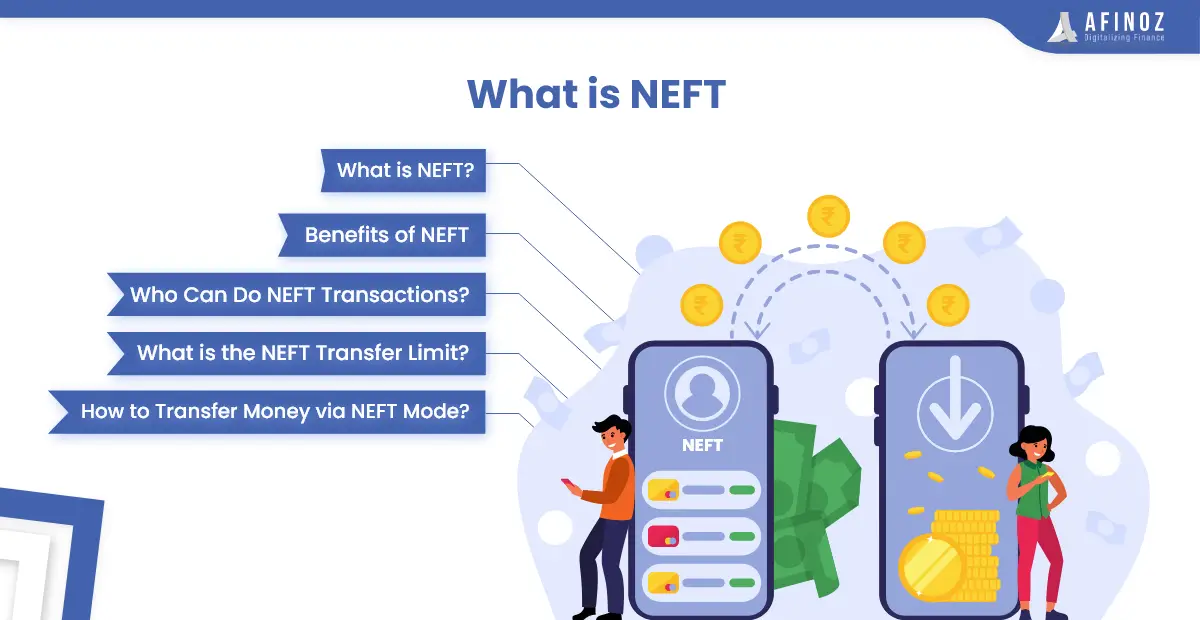If you carry out online transactions, most probably, you must have come across the term ‘NEFT’ among other money transfer modes in India. Thereby, in this blog today, we’re going to make you aware certainly about the same money transfer mode. So, without hovering around, let’s get started!
What is NEFT?
Well, NEFT is the abbreviation of the National Electronic Funds Transfer. NEFT is a one-to-one payment facility that's regulated by the monetary authority of India viz. Reserve Bank of India across various public and personal sector banks.
According to NEFT, one can carry out funds’ transfer to a different individual with an account in a different bank. Nevertheless, to enable this facility, the concerned bank accounts must be NEFT-enabled. The payments in accordance with the NEFT are processed and settled in half-hourly batches.
Benefits of NEFT
Some of the key advantages offered by NEFT (National Electronic Funds Transfer) payments are stated below:
- Transferring funds via NEFT is time saving, convenient and feasible.
- NEFT payments are solely electronic; therefore, no party is required face to face for payments of funds.
- The payment mode is safe and encrypted with firewalled gateways. So, ensures safety from frauds and thieves.
- Instant confirmation of transfer of funds to both the parties viz. the sender and the receiver.
- NEFT can be used as per the user's convenience within the prescribed time.
- NEFT dismantled the usage of cheques and Demand Drafts for the funds' transfer; thus, it's economical.
Who Can Do NEFT Transactions?
NEFT (National Electronic Funds Transfer) transactions can be made by all sorts of account holders, whether individuals, firms, or corporates. Nonetheless, this will be carried out, when the bank which holds the user account is NEFT-enabled by the RBI.
In some events, one can also transfer funds by means of NEFT even without a bank account. This can be performed by making cash deposits at an NEFT-enabled branch and giving details such as name, address, email id, and contact number. Nonetheless, this will be carried out just for transactions up to Rs. 50,000 and not beyond.
What is the NEFT Transfer Limit?
There are no limitations on the minimum and maximum amounts of transactions that can be made with NEFT (National Electronic Funds Transfer). While minimum transactions start from Rs. 1, the maximum can range up to any amount. Although, the sole restriction on NEFT transfer is that if a cash deposit takes place which is as stated above, range up to Rs. 50,000.
What is the NEFT Timing?
Unlike IMPS, NEFT (National Electronic Funds Transfer) does not work 24×7, it only works in accordance with the bank's prescribed time. Though the NEFT timing may differ across different banks yet, typically, the timings for Monday to Friday are 8 am to 6:30 pm, and for Saturdays, it is 8 am to 12 pm.
What are the NEFT Charges?
Following are the charges that are associated with NEFT (National Electronic Funds Transfer) transfers:
NEFT (National Electronic Funds Transfer) Charges
Transfer Amount
Charges
Up to Rs. 10,000
Rs. 2.5
Rs. 10,000 – Rs. 1 Lakh
Rs. 5
Rs. 1 Lakh – Rs. 2 Lakhs
Rs. 15
Above Rs. 2 Lakhs
Rs. 25
How to Transfer Money via NEFT Mode?
In order to transfer funds by means of the NEFT (National Electronic Funds Transfer) mode, you must follow the below-stated steps:
- Log in to the internet banking of your bank.
- Select ‘Fund Transfer'.
- Choose the ‘NEFT' mode.
- Choose the name of the beneficiary to whom you would like to send the funds.
- However, you must note that you can only choose a beneficiary if s/he has been already added to the list.
- In order to add a new beneficiary, click on ‘Add Beneficiary'.
- Enter the required details like account holder name, account number, and IFSC code among others.
- Verify the details, and click on ‘Confirm'.
- Confirm further by entering the 4-digit OTP received on your registered contact number.
- You can transfer funds to the newly added beneficiary after a certain time has been taken to feature him/her.
- On successful addition, choose the account details for which the transfer is to be made, and click on ‘Confirm'.
Top 10 Banks providing NEFT facility
Following are the Top 10 Banks that extend the facility of NEFT (National Electronic Funds Transfer) are:
- State Bank of India
- ICICI Bank
- Punjab National Bank
- HDFC Bank
- Axis Bank
- Union Bank of India
- Bank of Baroda
- Union Bank
- Canara Bank
- IDBI Bank
This demonstrates that both the public banks and private banks offer NEFT services to their account holders.
The Bottom Stroke
To wrap up, it's the foremost suitable mode of online payment which is out there at a cost-effective rate and the settlement time is also less as contrasted with other modes of payment. The RBI has introduced this technique to carry out online transactions of small value at a way reasonable rate.
Moreover, if you are seeking instant access to funds to fulfil your emergency expenses, no need to worry as Afinoz stands here to help you 24×7! To grab the best deal on an instant personal loan, business loan, or home loan, get a hold of us today!







